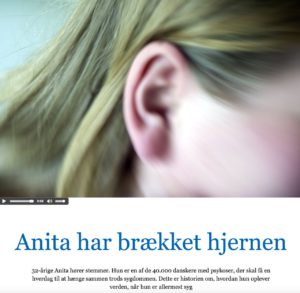(THIS ARTICLE IS MACHINE TRANSLATED by Google from Norwegian)
There is, of course, something going on in the exploration of the journalistic boundaries of these years. As such, the journalism and definition of it has always been negotiable. Just think of the relationship between literature and journalism and a genre such as the literary reportage that has borrowed narrative techniques from the literature and in that sense challenged and discussed journalistic conventions such as authenticity and truthfulness.
But these years we are witnessing a number of new journalistic expressions, which use both newer technological opportunities, but also challenge the prevailing perceptions of the journalistic role and the scope that has traditionally been assigned to the journalist.
 Anita has broken her brain. The multimodal non-fiction narrative is a story that is acquired journalistically through research and interviewing, but staged by combining different types of media and modalities such as sound, image, photo and film. The idea is that the different modalities have different functions, and when they act together, they impart a strength to the narrative that they cannot provide separately. An example of the multimodal, journalistic narrative is Anita has broken her brainthat deals with a woman who hears voices.
Anita has broken her brain. The multimodal non-fiction narrative is a story that is acquired journalistically through research and interviewing, but staged by combining different types of media and modalities such as sound, image, photo and film. The idea is that the different modalities have different functions, and when they act together, they impart a strength to the narrative that they cannot provide separately. An example of the multimodal, journalistic narrative is Anita has broken her brainthat deals with a woman who hears voices.
As soon as you enter the site, you are met by a staging of the theme. A shaky image showing a slice of a face focused on the ear vibrates on the screen while a female voice begins to tell how she hears a lot of people who are not there. This is followed by a longer staging of a portrait of a woman, who at the same time serves as a case to explain about an illness affecting 40 Danes every year.
The written is probably the most weighty element of the narrative, but you cannot ignore the many photographs that break the narrative and allow for other inputs and perhaps a different kind of empathy, nor can you ignore the different ones, fact-based graphics boxes as well as small audio clips that can be selected on and off the road. Exactly the interactivity or choice is a central part of the multimodal narrative, where the user's choices result in some variation of how the story is pieced together.
Anita has broken her brain. Sound, image, text and graphics. Organized by Kim Schou with photos by Leif Tuxen.
Off the Page and the journalistic live show. Here we are a bit further in the performative direction. The starting point is still a journalistically provided story from The Guardian's journalists, but in the project Off The Page the story is disseminated as performing arts in collaboration with The Royal Court Theater. The plays are created on the basis of conversations between the journalists and the theater director, and are visualized both as a play and as short films of 3–10 minutes. An example is the play / film Britain is not Eating, which, using the setup from the TV chef show and incorporating a fictional politician, delivers a satirical but journalistically grounded depiction of perhaps especially the conservative politicians' prejudices when it comes to class society.
Off the Page inscribes itself in a direction within what we could call performative journalism, ie journalism where the reporter, writer or host does not just take an active role in the narrative, such as when using a «jeg» in a text, but rather becomes a physical entity in the production of the text. This can be seen, for example, at the journalistic live shows such as Pop-Up Magazine in the United States and Zetland Live in Denmark. Here, journalistic stories are performed live in front of an audience. Structurally, the show mimics a magazine with different genres and a fixed flow, but something special happens when the person behind the story – or the media-created version of the person could also be said – becomes part of the performative performance of the story. Gone is the neutral mediator. The not only subjective but also committed and performing performer has entered. Whether it can and should be called journalism at all, there is certainly no agreement, but the examples here are at least obvious inputs for discussing the limits that may have to be set in the definition of journalism.
 Yahya Hassan's selfie videos. The Danish poet Yahya Hassan stormed onto the literary scene with the publication of his debut poems in 2013. Here was finally the voice from the immigrant community that both the right wing and the left wing had been waiting for. The poems were loud-mouthed (written with capitalists of course) and scolded both passive immigrant parents and streaks of failure from the surrounding community.
Yahya Hassan's selfie videos. The Danish poet Yahya Hassan stormed onto the literary scene with the publication of his debut poems in 2013. Here was finally the voice from the immigrant community that both the right wing and the left wing had been waiting for. The poems were loud-mouthed (written with capitalists of course) and scolded both passive immigrant parents and streaks of failure from the surrounding community.
Subsequently, Hassan became a media person par excellence. With his improvised, bloodthirsty and energetic approach, he was cultivated and loved by a host of Danish media, which very much liked to bring everything Hassan had in mind. The political parnas also attracted the poet. First, established parties discussed what Hassan actually said in his poems (perhaps the first time that politicians have discussed poetry in public?) And then Hassan explicitly became part of the political when the newly formed National Party got Hassan as a candidate in the general election. The party did not manage to get a line-up approved before the election, but the media coverage was fierce especially because of Hassan. And recently, the media coverage of the poet escalated once again. This time, the occasion was a series of incidents in which Hassan comes into conflict with both the police and the gentle streams of people who eventually have a thorn in their side for him. The coverage increased because Hassan himself mediated his handshake by recording a gentle stream of selfie videos, where he addresses the public, is chased by characters in faster cars, confronts the police or shows off a tending violent discussion with various individuals on the street. In this way, Hassan himself takes over some of the mediation of his persona, and contributes to the continuous narrative of Hassan. It can all of course be said to be a long PR prelude to his upcoming collection of poems, but regardless of the PR value in these videos, they are interesting to see as paratexts to the poems and as an example of what social media can contribute when it comes to negotiation about how an individual is told and constructed in the mainstream media.
Most videos are to be found on Yahya Hassan's facebook page:
Off the Page. example Shown Britain is not eating. 7 minutes
Journalistic live shows, a bit of Zetland Live can be experienced in film format here:

